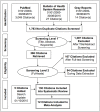How is Indonesia coping with its epidemic of chronic noncommunicable diseases? A systematic review with meta-analysis
- PMID: 28632767
- PMCID: PMC5478110
- DOI: 10.1371/journal.pone.0179186
How is Indonesia coping with its epidemic of chronic noncommunicable diseases? A systematic review with meta-analysis
Abstract
Background: Chronic noncommunicable diseases (NCDs) have emerged as a huge global health problem in low- and middle-income countries. The magnitude of the rise of NCDs is particularly visible in Southeast Asia where limited resources have been used to address this rising epidemic, as in the case of Indonesia. Robust evidence to measure growing NCD-related burdens at national and local levels and to aid national discussion on social determinants of health and intra-country inequalities is needed. The aim of this review is (i) to illustrate the burden of risk factors, morbidity, disability, and mortality related to NCDs; (ii) to identify existing policy and community interventions, including disease prevention and management strategies; and (iii) to investigate how and why an inequitable distribution of this burden can be explained in terms of the social determinants of health.
Methods: Our review followed the PRISMA guidelines for identifying, screening, and checking the eligibility and quality of relevant literature. We systematically searched electronic databases and gray literature for English- and Indonesian-language studies published between Jan 1, 2000 and October 1, 2015. We synthesized included studies in the form of a narrative synthesis and where possible meta-analyzed their data.
Results: On the basis of deductive qualitative content analysis, 130 included citations were grouped into seven topic areas: risk factors; morbidity; disability; mortality; disease management; interventions and prevention; and social determinants of health. A quantitative synthesis meta-analyzed a subset of studies related to the risk factors smoking, obesity, and hypertension.
Conclusions: Our findings echo the urgent need to expand routine risk factor surveillance and outcome monitoring and to integrate these into one national health information system. There is a stringent necessity to reorient and enhance health system responses to offer effective, realistic, and affordable ways to prevent and control NCDs through cost-effective interventions and a more structured approach to the delivery of high-quality primary care and equitable prevention and treatment strategies. Research on social determinants of health and policy-relevant research need to be expanded and strengthened to the extent that a reduction of the total NCD burden and inequalities therein should be treated as related and mutually reinforcing priorities.
Conflict of interest statement
Figures






References
-
- United Nations. The Millennium Development Goals Report 2015. New York United Nations, 2015.
-
- Global Burden of Disease Study 2013 Collaborators. Global, regional, and national incidence, prevalence, and years lived with disability for 301 acute and chronic diseases and injuries in 188 countries, 1990–2013: a systematic analysis for the Global Burden of Disease Study 2013. Lancet. 2015;386(9995):743–800. doi: 10.1016/S0140-6736(15)60692-4 ; PubMed Central PMCID: PMC4561509. - DOI - PMC - PubMed
-
- Magrath I, Seffrin J, Hill D, Burkart W, Badwe RA, Ngoma T. Non-communicable diseases. Please redress the balance of millennium development goals. BMJ. 2009;338:b2533 doi: 10.1136/bmj.b2533 . - DOI - PubMed
-
- Fehling M, Nelson BD, Venkatapuram S. Limitations of the Millennium Development Goals: a literature review. Global public health. 2013;8(10):1109–22. doi: 10.1080/17441692.2013.845676 ; PubMed Central PMCID: PMCPMC3877943. - DOI - PMC - PubMed
-
- Renzaho AM. The post-2015 development agenda for diabetes in sub-Saharan Africa: challenges and future directions. Global health action. 2015;8:27600 doi: 10.3402/gha.v8.27600 ; PubMed Central PMCID: PMCPMC4439422. - DOI - PMC - PubMed
Publication types
MeSH terms
LinkOut - more resources
Full Text Sources
Other Literature Sources
Medical

